Electronic access system for the office. Buy a turnstile for the entrance
Our company offers a wide range of solutions for organizing limited access to facilities of any size. The most popular option is to organize a checkpoint with turnstiles.
A turnstile is a universal technical solution that allows you to visually mark the entrance to a restricted access area and establish strict control over visits to the facility. Depending on the design, there may also be physical restrictions on access to the site.
Electronic checkpoints (all inside)Ready-made kits for installation on the "All-in" checkpoint. Everything is already installed inside necessary equipment for quick and easy turnstile installation. All that remains is to screw the turnstile to the floor, connect it to the computer network, and configure the program. |
|
Turnstiles-TripodsTripod is the most popular type of turnstile. The design is based on three rotating barrier bars. There are two main types of tripods: mounted and stationary. |
|
Pedestal turnstilesBollard turnstiles are designed to equip facilities with a large flow of people. The design of such turnstiles allows, when installed in a row, to form a passage area without the use of additional barriers. |
|
Rotary turnstilesHalf-height and full-height turnstiles (“turntables”). Provide the best and maximum degree security. |
|
Turnstiles Automatic SystemsAutomatic Systems is one of the leading companies in the production of equipment for organizing access control in access areas of enterprises, office and administrative buildings, for use as blocking devices as part of access systems for various objects (ports, airports, objects with increased access security, etc.). |
|
Card readersDevices used to automate the process of collecting guest cards from visitors. Usually located next to the turnstile or gate. When leaving the controlled area, the visitor inserts a guest access card into the card reader, after which the device allows passage. |
|
WicketsA type of inexpensive, compact turnstiles. Mechanical and electromechanical. |
|
FencingVarious fencing and their elements help to optimally “fit” the turnstile into the existing space. Made in the same style as the turnstiles, these additional elements allow you to create a single design without disturbing the existing interior |
|
Accessories for turnstilesOptional components for turnstiles, card readers, reader stands. |
Typically, a turnstile consists of four main elements:
- static body,
- opening part (varies depending on the turnstile type),
- conditional access controller (devices that perform user identification, from simple card readers to combined biometric scanners)
- software that accumulates, processes and systematizes information on the movement of personnel
Thanks to a wide selection constructive solutions, turnstiles can be used to restrict access to any entrance: from small narrow corridors to the halls of large industrial or office buildings. This versatility is achieved thanks to:
- Variety of shapes and designs of turnstiles:
- Modularity and scalability of the solution: depending on the parameters of the entrance, it is possible to install either one turnstile or an entire access area with dozens of turnstiles.
Today, turnstiles are used in educational institutions(schools, universities), at checkpoints production facilities and offices, at airports and train stations, in government offices, in banks and at any other sites where it is necessary to limit visits.
We offer the most common designs that have proven their effectiveness in practice. Each type of turnstile has certain advantages for which it can be recommended for the site:
- Tripods. Turnstiles for entrances with three rotating bars at an angle of 120 degrees to each other, one of which blocks the entrance. The most universal solution: cheap, simple, reliable.
- Rotary turnstiles. They are used for objects where it is necessary not only to mark passage restrictions, but also to create physical barriers to entry.
- Pedestal turnstiles. They are an analogue of tripods, only made in the form of a free-standing solid cabinet with a rotating element. Designed for a large flow of people, the key advantage is the ability to organize a checkpoint with numerous turnstiles without additional fencing and fittings.
- Full height turnstiles. A type of rotary turnstiles that completely block the passage. They are the most powerful physical barrier to penetration. While all other turnstiles require a security post that controls passage, a full-height turnstile provides protection against unauthorized access, while guaranteeing high speed letting people through.
1. Main types of actuators
The main task of all the devices listed below is to separate the user flow. Protect the area from uninvited guests it is also possible using a concrete fence with barbed wire and a right-of-way, but dividing, for example, a dense mass of workers and employees going to work in the morning into individual people, and not worsening the throughput of the checkpoint, is already a problem. The actuators of the access control system are designed to solve this problem.
Tasks solved by actuators in combination with others technical means SKD:
- Authorized access to the facility territory
- Dividing the flow of visitors
- Time tracking and timesheets
- Fight against terrorism
- Preventing the transport of material assets, explosives and radioactive substances
The operating principle of all the devices listed below is similar. The device is installed on the control line and is usually equipped with two readers. The user presents the card. If access is allowed, the device will unlock and allow only one person to enter. The possibility of only one person passing at a time is achieved either by physically limiting the space (when two people simply cannot squeeze in), or by using a system of presence sensors, pressure, a weight system and a rather complex operating algorithm.
2.1 Half height turnstiles
The class of half-height turnstiles is the most commonly used in practice. The class is quite extensive, it includes three-bar turnstiles, rotor turnstiles, controlled passage zones, all kinds of gates and other passage restrictions. There is one mandatory requirement for all half-height devices. They should only be installed in an area under constant security surveillance. Despite all sorts of technical tricks from manufacturers, you can jump over such devices, you can crawl under them, or, in extreme cases, throw some objects over them.
2.1.1 Three-bar turnstiles
A three-bar turnstile, popularly known as a “tripod,” is the simplest and most affordable device from a financial point of view. As a rule, it is a U-shaped body on which a cam with three bars is attached at an angle. Only one person can be between two bars at a time. Yes, you can jump over half-height turnstiles, but as I already said, they are installed only at checkpoints, where personnel are on duty around the clock, and the turnstile is under constant surveillance.
The device is quite simple with technical point vision, mostly devoid of serious electronics.
Rice. Three-bar turnstile
As a highlight, there are turnstiles with “breaking” bars. This is necessary primarily for firefighters to ensure quick evacuation in case of an emergency. Russian and Italian manufacturers They can only make mechanically breaking rods. Those. in order to open the passage, two or three “hefty fellows” need to lean on the bar, as a result of which the spring will be pulled back and the bar will “break”. In Germany they are used to doing without the help of “well done” people, who, by the way, may not be there. The patented German invention allows the booms to be lowered automatically upon a signal from a control panel or, for example, from a fire alarm panel.
2.1.2 Rotary turnstiles
Half-height rotary turnstiles are well known to us for Soviet times- they're in large quantities stood at the entrances of factories, institutes, etc. and were called “turntables”.
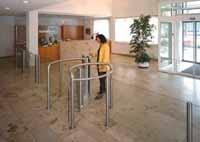
Rice. Rotary turnstile
The operating principle is simple. A column on which 3 or 4 rotating blades are attached. The user walks in the space between the two blades. It is possible to squeeze two people into the space between the blades, but this will not help, because... Just like tripods, these turnstiles must be under constant surveillance by a security guard.
The material from which the doors are made can vary from curved metal pipes to tinted tempered glass with metal or wood railings and handles. The main visible difference in the models different manufacturers- design and thickness of the column. Someone can hide the motor in a column of one hundred and forty millimeters, while others can only hide it in two hundred and twenty.
2.1.3 Controlled passage areas
There is another “well” familiar from the “old” times - automatic checkpoints or, as they are also called, controlled checkpoints. Even judging by the name it is clear that this decision specially designed for large flows of visitors. The main advantage of this equipment is the highest throughput of all existing models. The downside is that the turnstile is bulky and requires a lot of space for installation. Muscovites still encounter turnstiles of this type every day in the metro. In Europe, models with different types of sashes are produced, different designs housings.
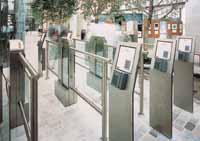
Rice. Controlled access areas
2.2 Full height turnstiles
Full height systems are primarily used for outdoor work. For the most part, these are rather ugly metal awards, consisting of a steel frame, a rotating central column with rods and a fence. They produce many modifications - for one or two passes, with straight or rounded rods, entirely made of polished stainless steel or painted, there are models with an additional roof with lighting and drainage. A number of manufacturers have in their assortment models with glass side panels and rods made of durable plastic.
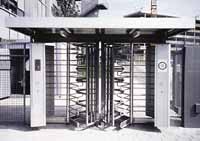
Rice. Full height turnstile
The principle of operation of such turnstiles is approximately the same. The user presented the card. If he has the right to do so, the turnstile will be unlocked. The turnstile is rotated manually (if there is no built-in motor) and the user, having passed between the doors, finds himself inside the protected area. If there is a built-in motor, the turnstile will automatically initiate movement after it receives an authorization signal from the access control system and the user “lightly” pushes it, initializing the rotation. Only one person can pass at a time and only in one direction. It prevents you from walking in another direction at the same time special design, preventing passage in the opposite direction.
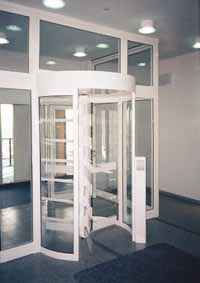
Rice. Full-height turnstile with glass side panels and durable plastic doors
The Germans have very interesting and useful know-how. Electronics allow you to track the position of a person in the turnstile. Until a person has passed a position that allows him to go to the opposite side, he can turn the turnstile in the opposite direction and go back. Italian, English and Russian manufacturers have a different position. If you go, you have to go through - there is no turning back.
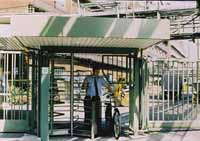
Rice. Full height turnstile with bike passage
And the Germans also have a special model that allows you to bring a bicycle through the turnstile together with a person, as well as a model with an integrated door. An integrated door is a very useful invention, for example, if you need to move a trolley or organize the evacuation of personnel, which is fundamentally important for an enterprise.
2.3 Automatic doors
Automatic doors have also found worthy application in enterprise access systems. Automatic door with bullet-resistant glass, equipped with readers, human position control sensors and even a weighing system, successfully limits access to the facility, divides the flow and, in addition, performs the functions of ordinary doors - protects the foyer from the cold and gives the facade of the facility, for example office building, matching appearance.
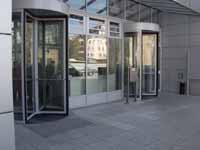
Rice. Automatic rotary doors equipped with access control systems at the entrance to one of the Moscow business centers
Entrance doors can be rotary (rotating doors) or sliding (cylinder with two doors at the entrance and two at the exit.
Unfortunately, this solution has not yet taken root in Russia, but many European companies opening offices in Russia opt for rotary doors and thereby instill good style in our soil.
2.4 Airlock cabins
A lock cabin is a device consisting of 2 doors that open sequentially. The automatic mode of operation of the gateway is illustrated in the figure.
Rice. The procedure for automatic operation of the airlock cabin
| The entrance is closed and locked. (Initial position) | |
| The door opens to allow the user to enter. | |
| The door closes automatically. Additionally, identification systems and various measuring systems can be installed inside the gateway | |
| Then either the second door opens, or if access is denied, the person entering is sent back. | |
| When a person exits the gateway, the gateway closes automatically. (Start position) |
Simultaneous opening of 2 doors is only possible in emergency evacuation mode. There are three main types of airlock cabins:
- lock cabin with swing doors, equipped with various types of devices - from door closers, electromagnetic or electromechanical locks to complex electric drives,
- lock cabins with sliding doors,
- lock cabins with rotating doors.
There are also models with folding doors, with rotating doors, etc.
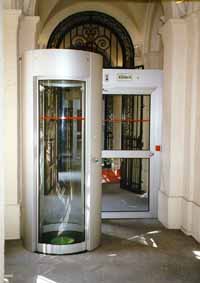
Rice. Airlock cabin
Airlock cabins are made from bulletproof or penetration-resistant materials and are certified for compliance with these standards.
Various types can be installed in the gateway additional devices- readers, intercoms, contact mats, weighing systems of various types (from single-range, giving an alarm when the weight goes beyond a previously set range, to full-fledged weighing systems that weigh the entire gateway and provide the access control system with the exact weight of the person in user cabin), metal detectors, gamma radiation and explosives detectors, etc.
Tab. Bandwidth various types equipment
2.5 Control of actuators
All listed devices can operate in 2 modes - manual and automatic. With manual control, a security guard or operator allows access to the facility by pressing a certain key on the control panel.
In automatic mode, the device operates without human intervention, but in conjunction with the access control system controller.
As a rule, the actuator has fairly “serious” electronics, which ensures that the device operates according to predetermined algorithms when signals are received from external ACS controllers. Unfortunately, not all manufacturers produce a full-fledged control board that allows integration into an existing system.
For example, in addition to the control commands sent to the actuator (“single entry”, “single exit”, “block”, “unblock”, etc.), the control board must output status signals and service signals (“single entry made” , “single exit completed”, “ready”, “attempted unauthorized entry”, “control unit housing open”, etc.). Without these signals, i.e. without feedback, it is impossible to build any serious access control system. For example, the controller and the system as a whole must clearly know whether, after reading the card, a pass was made or not. The algorithm depends on this further work the entire system.
3. Features of passage areas of various types of objects
3.1 Enterprise
The main parameter that you should pay attention to when choosing technical solution for a given type of object - throughput. As a rule, enterprises operate in shift mode, which means that the entire shift, which is usually several thousand people, passes through the checkpoint at least 2 times a day within 20-30 minutes. Therefore, when constructing a walk-through area, enterprises use equipment with maximum throughput.
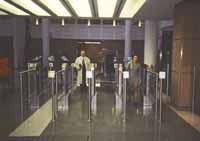
Rice. Passage areas
Let's do some math. Let’s take, for example, a turnstile of the “controlled passage zone” type. Maximum throughput 25 people per minute. In 20 minutes, a maximum of 500 people will pass through it. If an enterprise employs 3,000 people in one shift, then at least 6 turnstiles of this type are needed.
Controlled walk-through areas have another advantage - they are “normally open”. Those. if everything goes well, then the turnstile is practically not used, people come up, read their cards, they have access rights and are let through. The turnstile doors remain open and no mechanical parts wear out. Therefore, the service life of such a turnstile is practically unlimited. For intensive use, this is a very important feature.
The choice of turnstile also depends on the climatic conditions he will have to work. A number of enterprises have specially constructed checkpoint buildings that house checkpoint equipment. In this case, you can use rotary or three-bar turnstiles or walk-through areas.
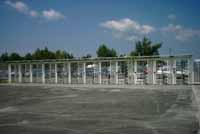
Rice. Full-height turnstiles at one of Renault's many factories around the world
But sometimes it becomes necessary to control the entrance to the site and install equipment directly on the street. Not every equipment can withstand heavy rain and 30-degree frost. Most often for work in street conditions full-height turnstiles are used that fit perfectly into the fence and can operate in all weather conditions. To protect against the effects of precipitation and low temperatures, they are equipped with special heaters and a roof.
Another feature of the entrance area of the enterprise is the need to maintain time records of visitors and integration with the “salary programs” of the enterprise. This does not apply directly to turnstiles, but this fact is very important when designing the entire access control system complex. Where and how working hours will be recorded, cards will be stored in factory lockers or handed out to employees - there are a lot of questions and their solution will depend on the configuration of the entrance area.
3.2 Office building
The equipment must fit into the interior and emphasize the purpose of the building. As a rule, rotary or less often three-bar turnstiles are used, which, together with fences, divide the hall into 2 zones. For visual monitoring of the turnstiles, issuing passes and receiving correspondence, a reception desk with a security post should be organized in the accessible part of the hall.
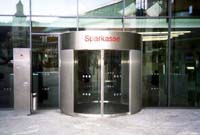
Rice. The main thing for an office building is to fit into the design
One of the increasingly popular options is rotary doors equipped with an access control system. It is both beautiful and does not require a large hall. The only problem is visitors, for them it is necessary to make a pass office outside the protected area.
3.3 Bank
A bank is, first of all, the highest possible security requirements. According to VNP 001-01 of the Bank of Russia (the main document on the basis of which the security system of any facility associated not only with the Central Bank, but also with commercial banks) is built, all external entrances to the facility must be equipped with airlock vestibules with glazing of a certain protection class.
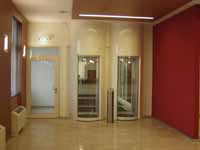
Rice. Airlock cabins in one of the Moscow banks
As a rule, the entrance to the bank is equipped with two, three or more locks (the number of booths depends on the estimated throughput), a metal detector and a security post booth. Evacuation passages should be organized near the airlock cabins, which can be used for carrying and transporting large cargo. Sometimes special loading gateways are used to deliver cargo.
One of the most controversial issues is the integration of airlock cabins and metal detectors. Generally speaking, the use of lock booths with a built-in metal detector is contrary to banking security standards.
Firstly, when manufacturing such a gateway, there are restrictions on the use metal parts so that there are no false alarms, for example when opening and closing the doors. As a result, parts appear made of plastic that does not meet the requirements for bullet resistance.
Secondly, due to limited space, not the highest quality (selective) detector is integrated into the gateway, and false alarms are guaranteed in advance. And this makes both security and users nervous. What should you do when the metal detector goes off - go out, put your things out, and then go back in again? And then go out again, pick up things and enter the ringing detector again?
And thirdly, it is possible to leave a gun there after entering the airlock (for example, stick it to the ceiling). If the gateway is not the most sophisticated, it will not determine this in any way. You can, of course, integrate a video camera and a motorized tray into the gateway, but this costs money, and a lot of it.
And in conclusion, the most damning argument. If you have a gateway with a built-in metal detector, then you open the outer door before you are even sure whether the visitor has a weapon or not. Thus, you reduce the level of security of your gateway by at least two times.
Therefore, in Europe, a metal detector is placed in front of the gateway, and at a distance of at least a meter, with the aim that, firstly, the moving doors do not create interference, and secondly, if a terrorist tries to break through to the gateway, the guards have time to block it.
3.4 “Regime” enterprise
A “secure” enterprise is an object whose security systems are subject to special, increased requirements. Such objects include factories and institutions of the chemical and nuclear industries, military facilities, etc.
As a rule, increased requirements are expressed in the need to use full-height systems that prevent jumping or throwing objects, the use of metal detectors and gamma detectors, the use of more complex identification methods and algorithms, such as video verification, biometric methods, etc.
Often, special inspection equipment and explosive detectors are used to prevent terrorist attacks.
A number of departments have developed special regulations, which regulate the type of equipment used.
Journal Security Algorithm No. 5 2002
Reviews Equipment for entrances “ACS turnstiles”.
Turnstiles are designed to regulate the process of passage at checkpoints and are one of the most common types of UPU along with electric locks.
Turnstiles can be represented as follows:
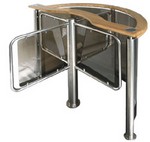
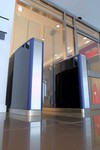
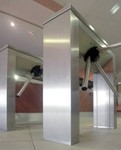
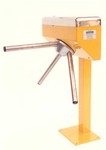
Type
– Security system equipment
Class– Access control systems (ACS)
Squad– Executive Devices (ED)
Family- Controlled Barrier Devices (UPD)
Genus– turnstiles
View– gates, tripods, rotary turnstiles, etc.
From the point of view of the main standard in the field of access control systems: GOST R 51241-98, turnstiles are actually one of the executive devices of access control systems and belong to the section “Controlled blocking devices” - (UPU).
In accordance with the same GOST, turnstiles classified:
1. According to the type of opening overlap:
- with partial covering of the opening
- with full overlap
- with blocking of an object in the opening (gateways, walk-through booths)
2. According to the method of controlling the UPU:
- with manual control
- with semi-automatic control
- with automatic control
I don’t think that in real communication the dry formulations of GOST are often heard, so I would venture to propose a more simplified classification of turnstiles, which, in my opinion, is more acceptable for the process of live communication between the seller, designer, installer and customer and reflects Key functionality of turnstiles:
- complete and incomplete covering of the opening;
- operating principle of the blocking element ("normally closed" and "normally open");
- presence or absence of an electromechanical drive;
- possibility of integration into access control system.
Let's try to consider the main types of turnstiles based on this classification.
Wickets.
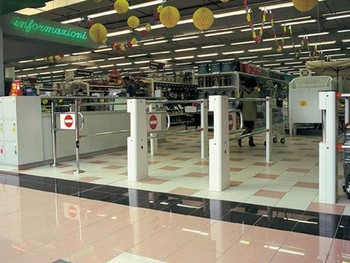
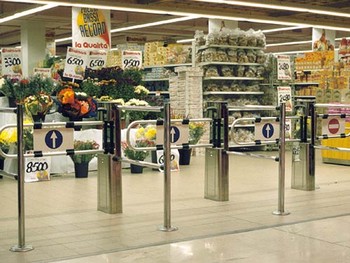
These are the cheapest and simple devices There are two types - mechanical and electromechanical - and provide exclusively incomplete covering of the opening.
Main application area mechanical gates – retail outlets, supermarkets or sports facilities. Such gates cannot be controlled externally (by an access system or from a remote control), therefore auxiliary equipment passable. Can be used in mechanical gates drive unit(closer) of two types - mechanical or hydraulic.
Electromechanical gates are often an addition to turnstiles of various types or an integral element of expensive supermarkets. In the first case, they are often integrated into access control systems and provide access for disabled people, as well as the passage of personnel with oversized cargo. In the second, this is, of course, one of the components of the image of a reputable store (in common parlance - pathos).
These UPU have two main modifications: with or without an electric drive. If there is an electric drive, the gate is controlled by a command from the remote control or from the access control system. A gate leaf without a drive must be pushed, but the cost of such models is lower.
Tripods
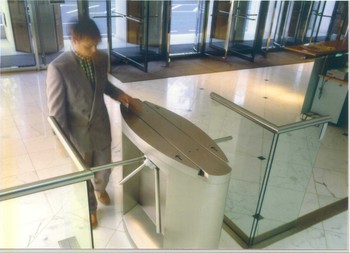
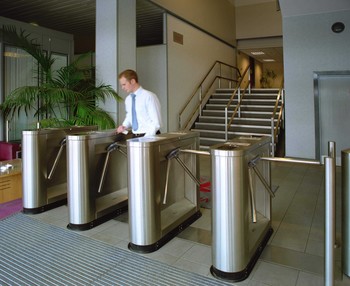
Tripods or three-bar turnstiles, like gates, they provide incomplete covering of the opening. Products of this class are present in the production line of almost all foreign and domestic manufacturers. In tripods, the blocking function is performed by three rods located on a rotating base at an angle of 120° relative to each other.
There are wall-mounted tripods (a rotating three-bar mechanism in a small case without a stand), with a stand and in a U-shaped case or (pedestal type, which have increased strength and tighter control of the flow of people).
Rotary waist turnstiles.
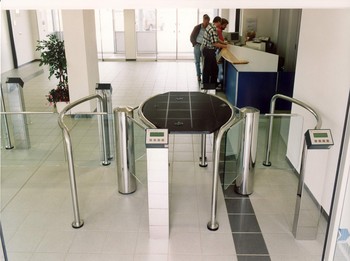
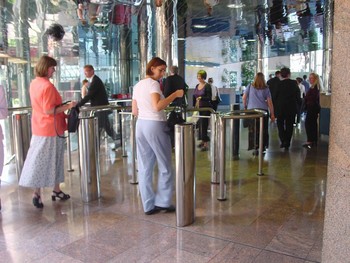
We can talk about two main groups of such turnstiles: mechanical And electromechanical.
Of the mechanical ones, the most widely used are the so-called “turntables”. The blades of these turnstiles are usually made of metal tubes and cover only a small part of the passage. This is one of the cheapest turnstile options even in its class.
Electromechanical rotor turnstiles, which belong to the elite and one of the most expensive groups of turnstiles, are a different matter.
The main element of the electromechanics of such turnstiles is a rotating rotor, which is a vertical column with blades (three or four) attached to it and a built-in electric drive. The blades can be made of metal rods, shockproof glass, plastic, etc. Sometimes they are supplemented with protective and decorative overlays or metal arches. By covering the lower part of the opening, such turnstiles completely eliminate the possibility of crawling under them. Rotary turnstiles are usually positioned by most manufacturers as elite turnstiles for office use.
Turnstiles with retractable doors.
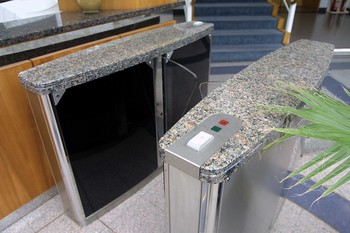
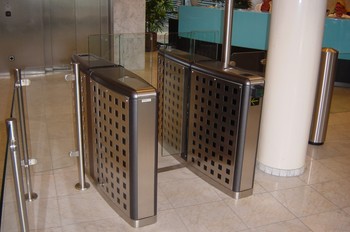
This type of turnstiles is well known to everyone in the metro. Their bodies can be metal or fiberglass (recent trends). Sliding doors on an electric drive are manufactured at the customer's request from different materials(plastic, shockproof glass, etc.) have different shape and size.
In the most serious modifications, the doors can have a height of more than 1.5 m. The ability to operate in a “normally open” mode, a clear light indication built into the turnstile body, all this provides a special – friendly mood for the visitor, increases the speed of passage and does not create psychological discomfort.
Usually this type turnstiles equipped whole a number of built-in security systems. For example, a system of infrared photocells to control access through a checkpoint and determine the number of simultaneously passing users. It allows you to detect any attempt at unauthorized passage, as well as an attempt to follow a person (“tail”) who has the right of access through the checkpoint.
Turnstiles with electric sliding doors are one of the most good options for facilities with a large number of people and, at the same time, high safety requirements. However, the cost of such turnstiles is several times higher than the cost of tripods.
Turnstiles with electric flaps.
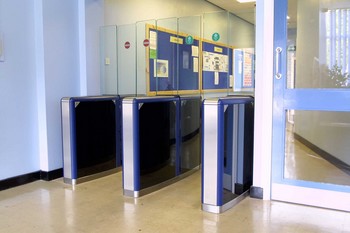
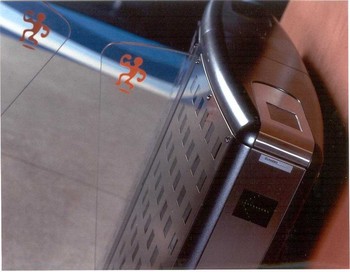
In fact, such turnstiles are a system of 2 or 4 motor gates integrated into one housing or installed separately. The gates are located opposite each other and can operate in both “normally open” and “normally closed” modes. Sometimes they are integrated into a power fence (metal guide rods) and have external racks for ACS readers. From different manufacturers, sashes can be made of metal pipes, impact-resistant glass and fiberglass. Like turnstiles with retractable leaves, this type is optimal for intensive use and ensures high passage security.
Rotary full-profile or full-height turnstiles.
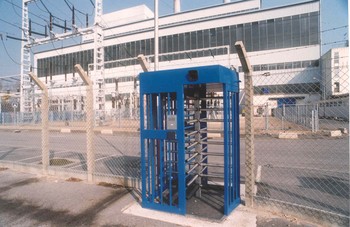
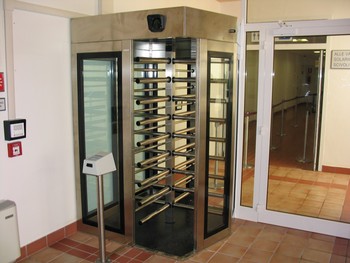
These turnstiles are most often used to organize passageways in places with increased security requirements, since they provide complete closure of the opening.
Full-height turnstiles are often integrated into engineering perimeter protection structures (fences, fences, etc.) and are used to build remote access points to the enterprise territory. There are, however, modifications that can also be used for office use.
The basic design of a full-height turnstile consists of a central column (rotor), no less than 1900 mm high, to which powerful metal rods are horizontally attached. Rows of rods form one, three or four planes that limit the passage. Like the waist version, full-height turnstiles allow people to pass through one at a time.
There are essentially two principles of operation of the turnstile locking mechanism: “normally closed” and “normally open”.
In the “normally open” operating mode, the turnstiles leave the passage open until the moment of unauthorized intervention. This mode is especially relevant for transport facilities and large enterprises with a lot of staff. In turn, the “normally closed” mode provides more high level security.
And finally, turnstiles differ according to climatic version: for indoor and outdoor installation.
Major turnstile manufacturers
Russian companies:
- Algont (Kaluga),
- K-engineering (St. Petersburg),
- OMA (St. Petersburg),
- PERCo (St. Petersburg),
- RostEuroStroy (Rostov-on-Don).
Foreign companies:
- Automatic Systems s.a. (Belgium),
- Gunnebo Entrance Control – Italdis Line (Italy),
- Gunnebo Entrance Control - Mayor Line (England-Sweden),
- KABA Gallenschuetz GmbH (Germany),
- WANZL (Germany).
Market: state and trends
The practice of selling turnstiles both in the domestic and foreign markets is quite transparent. This is, as a rule, a classic distribution. At least when it comes to turnstiles from the world's leading manufacturers:
The most popular and inexpensive models Usually available in distributors' warehouses. Expensive exclusive turnstiles are made to order. The situation is similar for domestic manufacturers. None of them will also make expensive turnstiles for future use and keep them in stock working capital companies.
As for organizing the sales process, in some cases the picture varies:
If a foreign manufacturer usually sells its equipment through distributors and not a single, even the most promising and profitable customer can buy this equipment directly, then domestic manufacturers often strive to sell themselves. Even those of them who adhere to the policy of promoting their products through intermediaries and have a good dealer network are unlikely to refuse a large customer who contacts them directly.
This feature Russian market I interpret it as some immaturity domestic manufacturer, or just greed. The fact that some large security market companies with dealers in the regions open their representative offices and branches in the same regions, which often perform the same functions, is another confirmation of this.
Main market development trends
First – in line with the global process of globalization. It's about about the purchase large companies smaller ones. The most striking example is the purchase by the Gunnebo concern of the Italian company Italdis Industria. Both companies were well known in the world and in Russia at the time of the transaction. I am confident that this process will continue. I do not rule out that to some extent it may also affect Russian manufacturers.
Second trend
is that the polarization between budget lines of mass products and exclusive models that are made to order is becoming more and more noticeable. Demand for models in the middle price niche is falling. Either the customer wants cheap equipment, or is ready to pay for an exclusive. The exception, perhaps, is high-speed turnstiles with retractable leaves - this equipment is used to solve specific highly specialized tasks and is intended for objects with high traffic. It has a specific design and a number of mandatory characteristics, for example, the ability to work in the “always open” mode. Despite the fact that such turnstiles are not cheap, the demand for them is stable, because there are objects where they are irreplaceable and there is no alternative.
I did not set myself the task of deeply analyzing this rather narrow segment of the security market, but, of course, it is impossible not to talk about its most important indicator, which is competition.
The fact that our manufacturers today compete with foreign colleagues in all price niches is a fact, and a gratifying fact. And this is no coincidence. It is logical that Russian developers started with the simplest things and achieved obvious and impressive success. But we must admit that so far this competition is most successful in the lower price category, primarily due to lower prices.
At all low price– this is, of course, a strong argument for competition. But it’s far from the only one. If cost were the only selection criterion, foreign models of the same “tripods” would have already disappeared from the Russian market. It is clear that no dealer has the opportunity to sell foreign equipment at manufacturer prices, because there are also delivery costs, customs duties, etc. But there are many more criteria besides price by which the customer chooses security equipment and turnstiles, among others.
As for more expensive models, many Russian manufacturers also make them today. But here the situation is somewhat different. Western equipment still dominates, because there is much more experience in its production abroad, and the volumes cannot even be compared. If any Russian company makes twenty or even two hundred exclusive turnstiles a year, then their foreign colleagues make several thousand. And the customer of this category of equipment is very demanding.
What does the customer prefer? What is the motivation behind his decisions??
Very current issues problems that many installers encounter. Here it is important to understand what the customer needs, what problem he solves by installing turnstiles. Because the choice of equipment is determined by the safety requirements of the facility. If, for example, it is necessary to completely block the opening, a full-height turnstile is needed, and there cannot be any other options. Moreover, at some serious objects it may be necessary to exclude the possibility of throwing in any objects. In such cases, it is best to use a gateway rather than a turnstile. But gateways cannot provide a lot of traffic, so a normal installer can and should offer the customer options that are acceptable to him. Moreover, the offers available today on the world turnstile market - and Russia, of course, is part of this market - make it possible to successfully solve any, even the most complex, customer problem.
